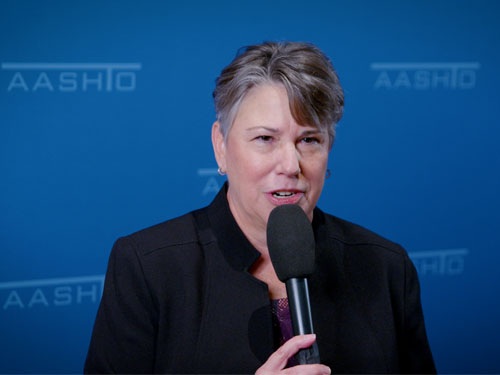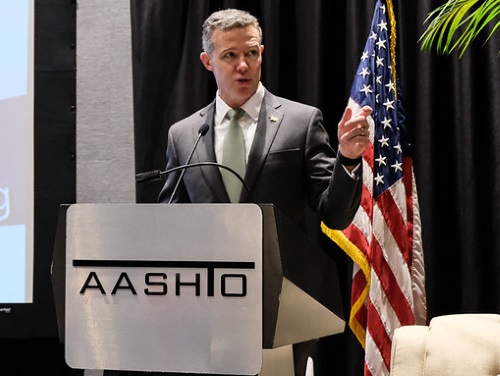Jim Tymon (seen above), executive director of the American Association of State Highway and Transportation Officials, appeared on the first Institute of Transportation Engineers podcast for 2021 to provide a look back at the challenges faced by the transportation industry in 2020, as well as a look forward on the Biden-Harris administration’s effort to advance a major infrastructure investment package.
In terms of the administration’s infrastructure investment plans, Tymon said the nomination of former presidential candidate Pete Buttigieg to be U.S. Department of Transportation secretary would help that effort along.

“We have already heard a lot from the administration about prioritizing investment in infrastructure and transportation – with the focus in the first part of this year here on passing a large package,” he said. “In Mayor Pete [as USDOT secretary], we have a great personality – someone who can work across party lines to build consensus. That only helps us advance investment in infrastructure. I think he has all the tools to do that successfully.”
Tymon noted that “2020 was a trying year for the entire country,” but in terms of the transportation industry and state departments of transportation in particular “it was really tough – especially at the beginning of the [COVID-19] pandemic, when a significant drop-off in vehicle miles traveled (VMT) caused them to alter their day-to-day business models.”

Tymon explained on the 20-minute ITE Talks Transportation podcast that despite state transportation revenues falling 40 percent to 60 percent in the first two to three months of the pandemic due to reductions in motor vehicle travel, state DOTs “still had to make sure transportation system remained operational – food and medicine don’t just magically end up on store shelves. Our nation’s transportation network is how we stock those shelves.”
He added that declines in VMT translates into less motor fuel tax revenue – which has a direct impact on state DOT budgets.
“So many rely on state fuel tax revenues to run their departments that to see a 40 percent to 60 percent reduction in revenues even for just two to three months is revenue they will never get back: even though travel has rebounded a little quicker than we thought it would,” Tymon said. “State DOTs lost a significant percentage of what [revenues] they expected. While they did a phenomenal job prioritizing operational activities in light of those declines, they took a significant budget hit.”

That is one reason why AASHTO pressed Congress for stopgap COVID-19 relief funding for state DOTs in 2020 – with Congress ultimately providing $10 billion in aid via a final year-end legislative package passed in December 2020.
Tymon added that while many Americans “hunkered down” to comply with stay-at-home orders issued to stem the spread of the COVID-19 virus, “state DOT workers had to be out to make sure our transportation system kept running. That provided clarification as to how critical state DOTs are to the nation’s economy, especially as many are now involved in the distribution of [COVID-19] vaccines. That shows state DOTs occupy an essential role in this country.”
Yet Tymon also noted that one unfinished piece of business remains from 2020: passage of a long-term surface transportation reauthorization package.
“One of our big victories in 2020 was that instead of short extensions, Congress enacted a full-year extension [of the Fixing America’s Surface Transportation or FAST Act] to get us through September 2021,” he said. “Congress showed a lot of foresight to do that, but it means we must get down to business to ensure we get long-term reauthorization across finish line this year.”

Tymon said AASHTO is looking for reauthorization to be “done on time” and be “long-term” – anywhere from five to six years – to provide state DOTs and transit agencies with “the time they need” to plan for major projects stretching across multiple years .
“A one- or two-year bill makes it hard to plan long term; it does not provide funding predictability for long-term projects,” he noted.
Tymon added that AASHTO would love to help Congress develop a “long-term sustainable revenue solution” for the Highway Trust Fund as well.
“Motor fuel taxes are not keeping up with level of [transportation] spending at federal level,” Tymon explained. “Congress is constantly having to bail out the Highway Trust Fund with general fund transfers.”
Key to that effort, however, is retaining the traditional formula-based disbursement for federal transportation funding. “Formula-funding is the ‘bread and butter’ for state DOTs – it allows them to prioritize the most ready-to-go projects with the most impact; enabling them to get that money out the door quickly to create jobs and improve the nation’s transportation network.”
 Top Stories
Top Stories
USDOT Makes $1.5B Worth of BUILD Grants Available
December 19, 2025 Top Stories
Top Stories

